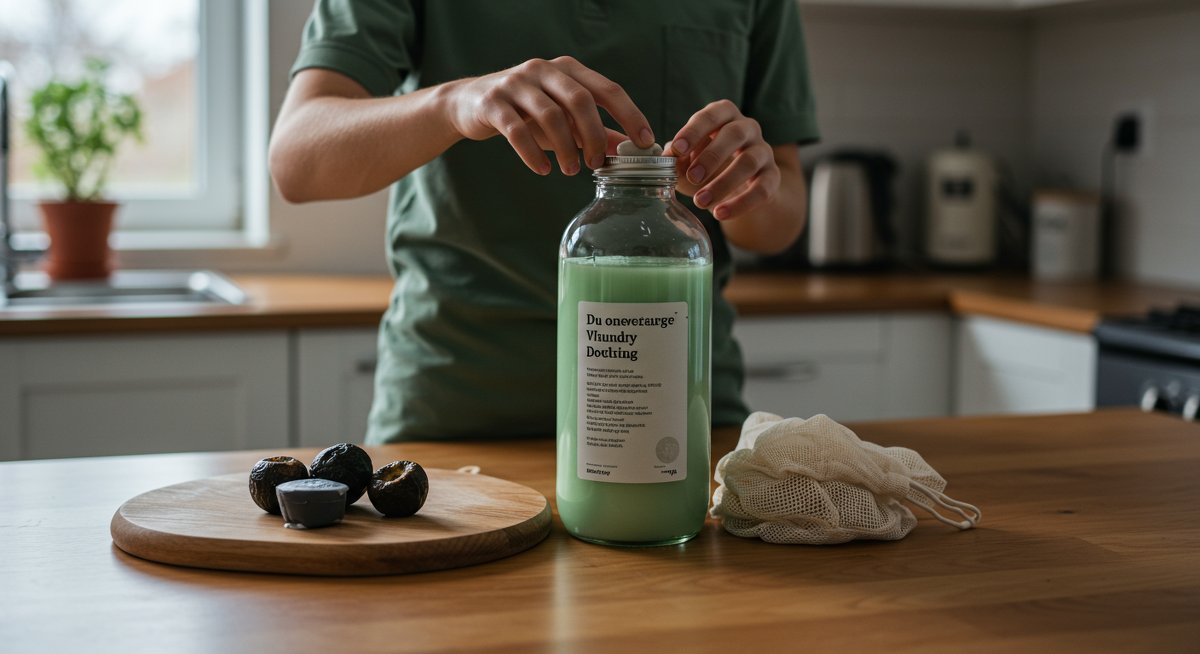Making your home greener starts with small changes, and one of the easiest places to begin is your laundry room. Traditional laundry practices can be surprisingly wasteful, consuming significant amounts of water and energy, and contributing to microplastic pollution. This guide offers a simple, accessible, and practical approach to eco-friendly laundry, perfect for beginners eager to reduce their environmental impact.

Why Embracing Eco-Friendly Laundry Matters for a Greener Life
Your laundry routine has a bigger impact than you might realize. A standard washing machine can use anywhere from 15 to 45 gallons of water per load, and the energy used to heat the water and run the machine adds to your carbon footprint. Furthermore, many conventional detergents contain harsh chemicals that can pollute waterways, and the microplastics released from synthetic fabrics during washing contribute to ocean pollution. Choosing eco-friendly laundry practices helps conserve resources, reduce pollution, and protect our planet for future generations. By making conscious choices, you contribute to cleaner water, less energy consumption, and a healthier environment.
For example, consider the water usage alone. According to the EPA, the average American family washes about 300 loads of laundry per year. If each load uses an average of 25 gallons of water, that's 7,500 gallons of water used annually just for washing clothes! Switching to more efficient machines and practices can significantly reduce this number, saving both water and money.
Essential First Steps to Get Started
Starting an eco-friendly laundry routine doesn't require a complete overhaul. Begin with these easy steps:
- Switch to Eco-Friendly Detergent: Look for plant-based, biodegradable detergents free from harsh chemicals, dyes, and fragrances. These are gentler on both your clothes and the environment.
- Wash in Cold Water: Around 90% of the energy used by a washing machine goes into heating the water. Washing in cold water is just as effective for many loads and can significantly reduce energy consumption.
- Air Dry Your Clothes: Line drying or using a drying rack eliminates the energy-intensive process of using a dryer, saving energy and extending the life of your clothes.
- Reduce Your Wash Frequency: Consider washing clothes only when necessary. Spot-clean stains and re-wear items whenever possible to reduce the number of loads you do each week.
Common Beginner Questions Answered
Is eco-friendly detergent as effective as regular detergent?
Yes! Many eco-friendly detergents are just as effective, if not more so, than conventional brands. They use plant-based ingredients that are powerful cleaners without the harsh chemicals. You might need to experiment to find the right detergent for your needs, but many options excel at stain removal and keeping your clothes fresh.
Will washing in cold water clean my clothes effectively?
Absolutely. Modern detergents are formulated to work effectively in cold water. Cold water is perfect for most clothes, preventing shrinking and fading, and it can even help remove some stains more effectively than hot water. Reserve hot water for heavily soiled items like bedding or towels.
How can I reduce plastic waste in my laundry routine?
Choose detergents that come in cardboard boxes or concentrated formulas that require less packaging. Also, consider buying laundry detergent sheets or tablets, which often come with minimal packaging, or making your own detergent.
Tips for Success (e.g., easy swaps, habit formation)
Easy Swaps for a Greener Laundry Routine
Making simple swaps can significantly reduce your environmental impact:
- Reusable Laundry Bags: Use mesh laundry bags for washing delicates and items that shed microfibers. This can help prevent microplastics from entering our waterways.
- Wool Dryer Balls: Replace dryer sheets with wool dryer balls. They reduce drying time, soften clothes, and eliminate the need for single-use dryer sheets.
- Refillable Detergent Bottles: Purchase detergent in bulk or buy refillable options to reduce plastic waste. Many eco-friendly brands offer concentrated formulas that require less packaging.
Habit Formation Strategies
- Set Reminders: Schedule laundry days or set reminders to wash clothes only when necessary.
- Batch Your Laundry: Wash full loads whenever possible to conserve water and energy.
- Create a Laundry Schedule: Establish a regular laundry schedule to avoid procrastination and ensure you're washing clothes efficiently.
Example: Air Drying vs. Dryer Usage
Consider the environmental impact of air drying versus using a dryer. A typical electric dryer consumes about 3 kWh of electricity per load. Depending on your electricity source, this can contribute significant greenhouse gas emissions. In contrast, air drying consumes zero energy and prevents wear and tear on your clothes, extending their lifespan. If you air dry just two loads of laundry per week, you can save a substantial amount of energy and reduce your carbon footprint considerably.
To further illustrate, the average cost to run a dryer load is roughly $0.30-$0.50 depending on your electricity rates. Over a year, with two loads per week, this translates to approximately $30-$50 spent on dryer usage. Air drying not only saves you money but also helps reduce emissions, making it a win-win solution.
Understanding Your Impact
To truly understand the impact of your laundry routine, consider these factors:
- Water Usage: How much water does your washing machine use per load? (Look for the WaterSense label on newer machines, or check your machine's manual.)
- Energy Consumption: How much energy does your dryer use? (Again, check the Energy Star label on your appliances.)
- Detergent Ingredients: Are the ingredients in your detergent biodegradable and free of harsh chemicals?
- Fabric Choice: The fabrics you choose also affect your footprint. Synthetic fabrics release microplastics when washed, and natural fabrics require more resources to produce and process.

Recommended Products for Newcomers
Here are some specific product recommendations to get you started:
- Eco-Friendly Detergent:
- Consider plant-based detergents like those offered by Pur Home , known for their effective cleaning power and eco-friendly formulations.
- Also, explore the options from Blueland, which focuses on minimizing packaging through their concentrated tablet system.
- Look for brands that prioritize sustainable sourcing and ethical manufacturing practices, and those with minimal packaging, or even the use of refillable systems.
- Reusable Laundry Bags: Using mesh laundry bags when washing synthetic clothing can prevent microplastics from entering our waterways.
- Wool Dryer Balls:
- Wool Dryer Balls are a fantastic alternative to dryer sheets. They can significantly reduce drying time, saving both energy and money, while also softening clothes naturally. Consider purchasing a set of wool dryer balls for your laundry routine.
Quick Troubleshooting Guide
- Detergent residue: If you notice detergent residue on your clothes, try using less detergent. Also, check your machine's water hardness and adjust the amount of detergent accordingly.
- Clothes not getting clean: Make sure you're not overloading your washing machine. Separate heavily soiled items from lightly soiled items. If necessary, pre-treat stains before washing.
- Musty smell: Clean your washing machine regularly (run an empty hot water cycle with vinegar) to prevent mold and mildew growth.
Next Steps in Your Green Journey
Once you've mastered the basics of eco-friendly laundry, consider these advanced steps:
- DIY Laundry Detergent: Making your own laundry detergent can be a fun and cost-effective way to control the ingredients and reduce waste. Many recipes use simple ingredients like washing soda, borax, and soap flakes.
- Energy-Efficient Appliances: If you're in the market for a new washing machine or dryer, look for Energy Star-certified models. These appliances use significantly less energy and water than older models.
- Microfiber Filters: Install a microfiber filter on your washing machine's drain hose to capture microplastics before they enter the water supply. These filters can drastically reduce the amount of plastic entering our oceans.
By taking these steps and making eco-friendly laundry a regular part of your routine, you can significantly reduce your environmental impact, conserve resources, and contribute to a healthier planet. It's a simple change with a big effect, and it's one that everyone can do.